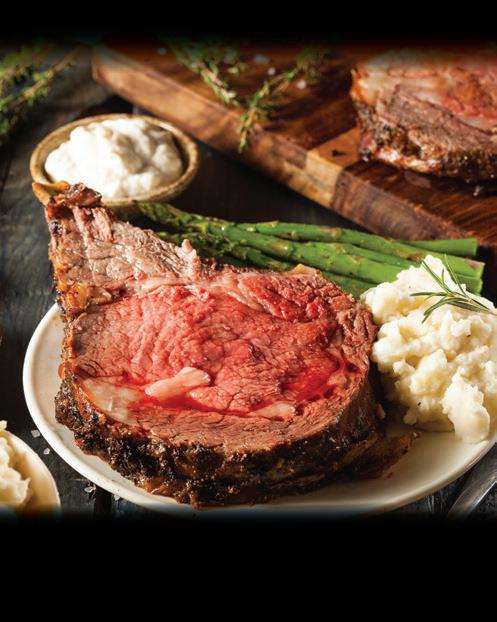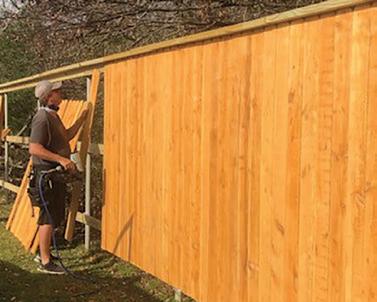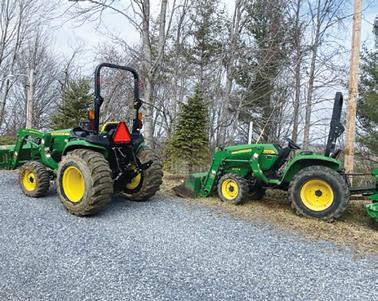

Roan Mountain Magazine









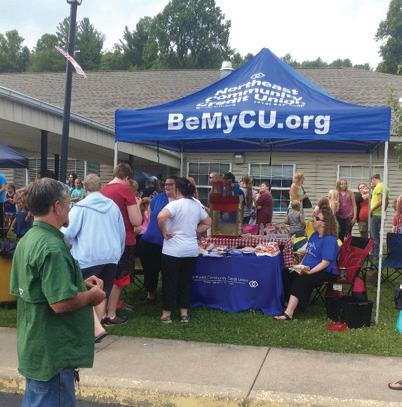

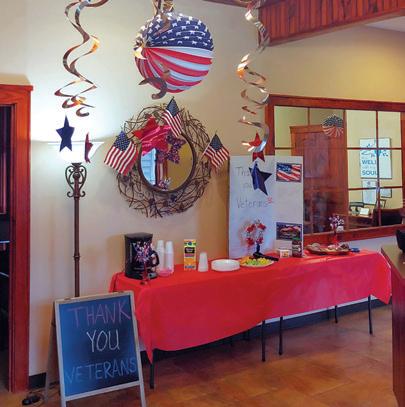








Roan Mountain Magazine
Volume 1, Issue 10
2025
STAFF
PUBLISHER/EDITOR
Amy Thurman
amy@roanmountainmagazine.com
EDITORIAL ASSISTANT
Diana Tolley
AD SALES, DISTRIBUTION, EDITORIAL
Susie Phillips
STAFF WRITER
Ericka Hughes
GUN TALK WITH JON
Captain Jon Strydom
NEWS FROM THE ROAN
CeCe Studer
PEACE OF MIND WITH CHRIS
Christopher Adams
THE LAST WORD & THE GRACE PLACE
Noah Blair
STAFF PHOTOGRAPHER
Faith Lynn
SOCIAL MEDIA MANAGER
Colleen Gainey
CONTRIBUTORS
Renee Russell
Copyright © 2025
All content herein is copyright protected and may not be reproduced in whole or part without express written permission.
Roan Mountain Magazine is published monthly and can be found at multiple locations throughout the Roan Mountain area, free to readers. We are not currently offering print subscriptions, but please contact us if you are unable to find a copy. (423) 440-9012
Read the Digital Version at: www.RoanMountainMagazine.com

Visit us on Facebook: Facebook.com/RoanMtnMagazine
Roan Mountain Magazine is printed by The Elizabethton Star Letters to the Editor: We would love to hear from you! Questions, comments, ideas, or whatever you’d like to share, please send to Amy: amy@roanmountainmagazine.com
ARTICLES & FEATURES
17 Best of the Roan Contest
Vote on multiple categories. Results to be shared in September.
20 Understanding Yellow Jackets
Nemesis or beneficial insect? Ericka fills us in.
22 Lightning!
Brush up on your knowledge of lightning and safety tips.
25 Heat Safety
As we head into the Dog Days of summer, don't let the heat beat you.
27 Music Spotlight
Ericka shares her appreciation for Charlie Daniels.
Gun Talk with Jon Taste of the Roan The Grace Place News from the Roan Peace of Mind wth Chris Lessons in Life/Landscaping Fun Page
The Last Word
All of us at Roan Mountain Magazine would like to wish you a happy Independence Day!
Stock photo
29 Resilient Roan
This month Renee talked with Nathan and Emily Purcell.
30 Beneath the Fireworks
Tips on helping your furry household members cope with fireworks.
31 Summer Concert Series
Band schedule for both the state park and Eric Anderson park concerts.
32 The Price of Freedom
A short story by Diana Tolley set during the American Revolution.
34 New Social Media Guru
Colleen Gainey has joined the magazine team to handle Facebook.
37 We Look To The Sky
An original poem by Ericka Hughes.





It’s been a busy and exciting month for me, since I last sat down to write this column. In May, I began the process of moving out of the flood zone in the village to a lovely spot off Shell Creek. Although there’s still some fine-tuning to be done, I’m mostly settled in and loving my “new-to-me” home. I have a large front porch where I can sit of an evening and watch my happy chickens in their huge, shaded and grassy pen. The windows of my office look out at Hump Mountain and seeing the play of sunlight or fog or storms rolling in is a neverending source of pleasure and inspiration. It’s quiet and peaceful and I love it!
I also finally got my garden in this month! I have no idea how it will do as I was about six weeks later than everyone else, and I’m still learning the differences between what works here versus what worked in Georgia. But my tomato plants are looking healthy and happy, as are the cukes and various peppers. My okra has sprouted, as have the sunflowers and a couple watermelons. My green onions haven’t come up, which is disappointing, nor have the leeks, but those were just an experiment anyway. I don’t even really know what to do with leeks other than a recipe I have for potato leek soup that just sounded tasty.
There are flower beds in front of my house, but I’ve decided to plant them in herbs, lettuce and cherry tomatoes this year, rather than flowers. I’ll plant flowers next year when I’ve had time to think about what I want.
I’ve also gotten seeds for red cabbage, Brussels sprouts, pumpkins, collard greens (my favorite) and a few other fall vegetables that I’ll be starting soon, when the time is right. I’ve never grown any of these things, so wish me luck! I also found a small cucumber variety that grows in a pot on a sunny windowsill indoors that I’m looking forward to trying! Cucumbers in winter? That’ll be heavenly!
But the best thing that’s happened this month is the arrival of my son, Jay. As mothers, we have to accept that our children are going to live their own lives and often that means paths leading away from home, away from us. And when that happens, pieces of our hearts go with them.
Jay visited over the holidays in December and loved it here: the kindness of the people he met, the views, and the slower pace of life. Where being a Christian isn’t considered backwards, where people help each other, and yeah, where Mama is. So a piece of my heart is back in place.
Some of you may have already met him. When he noticed that magazines were running low at a few local businesses, he made of point of coming by to get more and delivered them to you. Up to this point, Susie and I have been dividing the distribution with her handling everything outside of the village and me handling the village, but I’ll probably turn that over to Jay so I can
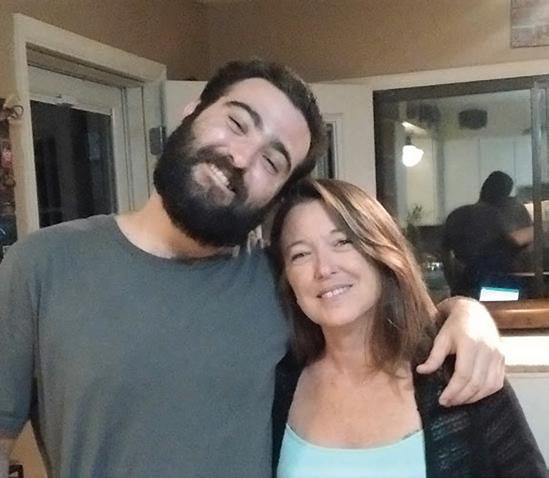
focus on the layout and other tasks. He’s also started working with Johnson’s Lawn Care and may help Tammy out at Whiteway occasionally when she needs an extra set of hands in the kitchen.
Jay and his girlfriend, Karen (who plans to join him here in February), also have a plan I’m really excited about. They’re looking for a good location for a country store to carry locally produced items, such as jams, honey, soaps, and hand-crafted things, like woodworking, quilts, artwork, and more. Once a location has been determined, they’ll put the word out to local artisans, crafters, and other creators. There’s so much creativity here and it would be so good for all involved! Stay tuned for more to come on that.
But for me, the best part is just having my son nearby. Knowing he’s 10 minutes down the road, being able to share a meal, celebrate special occasions together. My child is in hugging distance, and this mama couldn’t be happier!
I hope y’all are enjoying the summer and good things are happening in your lives, as well!
See you 'round the Roan!
Amy Campbell Clark Editor amy@roanmountainmagazine.com
My favorite picture of the two of us together. There will be plenty of opportunities for more pictures now!








Early June, on a quiet day in the shop, an elderly gentleman walked in with an even older Colt revolver. After the pleasantries were over, he asked if I could reblue his revolver.
"Yes, no problem," I replied and began entering it into the ledger. When it came to the serial number, I commented on it being a low series and the client replied that he had documentation from the Colt factory in his truck.
To cut to the chase here’s a section from the pages he handed to me:
COLT M1873 SAA
U.S. CAVALRY REVOLVER #4995
This revolver was possibly and with a high degree of probability, issued to Custer's 7th Cavalry, in 1874 and possibly lost at the Battle of the Little Big Horn on June 26, 1876 ... “
All the hair on my arms was standing at attention! And more:
"From the full extent of information available it is quite apparent that Custer's troopers fought at the Little Big Horn with their original 1874 issue revolvers, with very few exceptions. Companies C, E, F, and L, the Custer Detachment which was annihilated, appear to have been almost exclusively armed with the 1874 shipment forwarded from the Rock Island Arsenal. As such, these revolvers most probably reflected serial numbers from the fourth, fifth and sixth production lots of 1000 revolvers (#3438 to #6530).”
From Custer Battle Guns by John S. Dumont.
An estimated 356 revolvers of the 7th's estimated 936 revolvers were lost in the battle. It seems this one was found. Some work had been done to it over the years and the Colt documentation describes it in detail.
For that old Colt to have been lost in battle during Custer’s Last Stand, in Montana, and eventually end up in my shop here in Tennessee, is a wonder! But I learned many decades ago to never underestimate old weapons – or old people. We all have our histories.
And the revolver itself? I very carefully and thoroughly cleaned it, oiled it, wrapped it in clean oilcloth and explained why it should never be refinished or re-blued. The client will be keeping that piece of history very safely in future.
If you’d like to read the two-page documentation from Colt, swing on by the shop.
As always - stay safe out there.
GUN TALK WITH JON
A Piece of History
By Captain Jon Strydom (aka African Jon)


Left and right side views of this old Colt, over 150 years after production.
Photos by Jon Strydom







INGREDIENTS
1 rack baby back ribs
Equal parts beer and water (enough to cover ribs in a stockpot or dutch oven)**
1 Zatarain’s Shrimp & Crab Boil
2 lemons, cut in half
1 medium yellow (or Vidalia) onion, cut in half
3 garlic cloves, peeled and cut in halves
2 jalapeno peppers, cut in half (seed removal optional)
Olive oil (spray can is easiest)
Zatarain’s Creole seasoning
** The alcohol in beer cooks off, but you can use plain water, chicken broth, or non-alcohol beer instead if you prefer.
DIRECTIONS
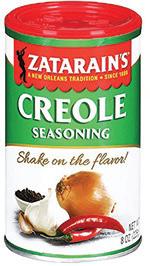
▪ Cut rack of ribs into quarters and place in stock pot or any pot large enough to hold them.
▪ Cover ribs with equal parts beer and water
▪ Squeeze lemons into pot then put the rinds in as well, then add shrimp boil bag, onion, garlic and jalapenos.
▪ Bring to boil over high heat, then cover and simmer over low heat for 30-40 minutes.
▪ When you put the ribs on to boil, start your grill if using charcoal, to make sure they're good and hot (wait until done if using gas, then set the flame high).
▪ When ribs are tender, remove from pot and brush or spray with olive oil, then sprinkle with Creole seasoning. Creole seasoning can have a bite, so watch out!
▪ Place on hot grill and monitor closely. Leave on just long enough for a good sear, then remove and serve immediately.
Notes
- I pour a little cup of the cooking broth to dip some of the drier bits of rib meat in while eating.
- After you put the ribs on the grill, throw a pound or two of shrimp in the rib broth pot, bring to a boil then turn it off. Serve the shrimp hot or drain and put on a bowl of ice in the freezer for a couple minutes and serve cold.
- I’ve tried this with country-style ribs but they don’t come out the same.
TASTE ROAN of the
Big Easy Ribs
Submitted by Amy Campbell Clark
Some may consider ribs without barbecue sauce a bit of a sacrilege, but I promise you, these are fall-off-thebone tender and have an amazing flavor. I found this recipe years ago in my favorite Cajun cookbook and have adapted it over time to make it my own. Great with homemade mac & cheese or potato salad for your Independence Day celebrations. Enjoy!


Have a recipe to share? We might be able to include it in an upcoming issue. Ideally with seasonally available ingredients, and if you have a photo of the prepared dish, send that along too! amy@roanmountainmagazine.com

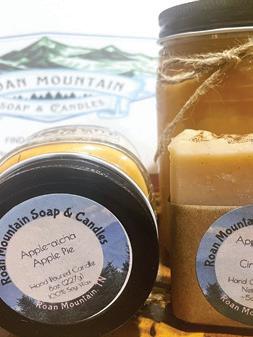

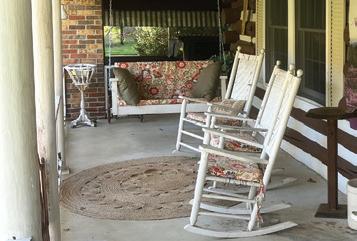





Jesus, Yeshua or Lisoús, each language will have its name for the Son of God but all will have to ask the same question of themselves: What does this name mean to me? There is no question we will ever ask ourselves as life-altering as this.
Jesus’ name can cause a stirring of emotion or memories, it can bring joy to some, while others may feel hurt or pain just from hearing the name. What I want to do in as few words as necessary, is to hopefully show that the name Jesus should bring joy to all who hear the name and it can change your life, impacting generations after you.
Let’s first start with the Christian community. The name Jesus is the very foundation of it all! Jesus, the man, came down from His home in heaven to minister and love those He met on his way to Calvary. He gave His life on the cross to offer mankind a way to the Father, by the forgiveness of our sins and in becoming the sacrifice Himself. When He rose from the grave He promised to return and bring us to live eternally in heaven. Jesus’ name is the most powerful name in the history of mankind and can bring peace that passeth all understanding (Philippians 4:7), offer hope found nowhere else (Romans 15:13), and give you an abundant life (John 10:10), here on earth before we are called home one day.
With all the truly wonderful and life-changing news
GRACE PLACE THE
By Noah Blair
of Jesus and His promises to us, one might ask why are there so many people who feel negativity associated with his name? This is sadly far too common in the world today, and the short answer is the very same people who find joy in His name usually are the main problem. Christians are called to go and tell everyone they meet about the good news (Matthew 28:18-20) and to explain what now lives within them ( 1 Peter 3:15). While these are good goals and things we should all be doing as believers, we fall short on understanding the main reason why we are called to do so.
Colossians 4:5-6 says: “Walk in wisdom toward outsiders, making the best use of the time. Let your speech always be gracious, seasoned with salt, so that you may know how you ought to answer each person.” We go and tell people about Jesus because we are called to LOVE them. We are not called to be their judge (1 Corinthians 5:12) but to love them (1 John 4:19) and tell them about the man whose name can change their lives!
If you have been hurt and the name of Jesus brings up painful memories or emotions, I can assure you that Jesus nor His name are ever the cause and He is the only thing that can take the hurt away. If you are a believer and want to proclaim his name, remember we do so in genuine love. We are all sinners saved by God’s grace, end of story.
Jesus loves you!
Photo Photo by Faith Lynn










Miller Farmstead Tours
Have you ever wondered what life was like before all of modern conveniences? It took a lot of hard work and determination to settle in an unfamiliar area to make a life for yourself. That’s what the Millers did. They raised a family, grew crops, and tended to livestock, all without electricity, tractors, or running water. The Dave and Louisa Miller family settled in Ripshin Mountain in 1870, where three generations of Millers lived for over 90 years. In 1908 they built the home that now stands in Roan Mountain State Park. Their farmhouse is listed on the National Register of Historic Places because it reflects the lifestyle of rural subsistence farmers in Appalachia in the early 20th century.
We invite you to join park staff for a guided tour of the Miller Farmhouse and learn more about the history of Roan Mountain and the people who have called it home for generations. The home is open for tours at 11:00 am, 1:00 pm, and 2:00 pm, and takes approximately 45 minutes. The cost is $10 per adult (13 years and older); $8 per senior (62 years or older); and $4 per child (12 years or younger). Check out our website at https://tnstateparks.com/roanmountain to book your tour and take a step back in time!
Interpretive Rangers
We are excited to welcome Andrea Price to Roan Mountain State Park as our full-time Park Interpretive Ranger. Andrea has worked previously at the park as a seasonal ranger and brings a wealth of knowledge of Appalachian history and subsistence duties to our park. She understands the cultural practices, resourcefulness, and ways of life that allowed Appalachian communities to thrive in the region's unique historical context.
Each year Roan Mountain State Park relies on part-time seasonal rangers to coordinate and facilitate programs in the park. This year we have two amazing seasonal rangers who will provide weekly educational programs about the natural and cultural history of our park. We are delighted to welcome back Kacie Rominger. Kacie spent her summer with us last year and we are happy to have her back this year. We also welcome Hannah Parry. This is Hannah’s first summer at Roan Mountain.
Are you interested in learning how to make butter, a corn husk doll, or learn about our animals in the park? Come and meet Kacie and Hannah on your next visit to our park and participate in one of the many free programs we will have throughout the summer. Information on programs and dates/times can be found on our website and are posted throughout the park.
NEWS FROM THE ROAN
By CeCe Studer Roan Mountain State Park

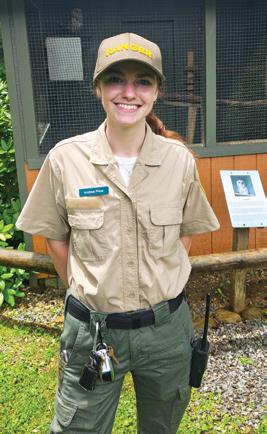
Bicycle Repair Station
Some of our most scenic areas in Roan Mountain State Park can be enjoyed on a bicycle. We now have a bike repair station in the campground. You can utilize the many tools available so you and your family can ensure your bikes are safe to ride. With biking being an eco-friendly way of travel and lots of fun, a bike repair station gives our guests the tools and ability to keep their bicycles on the road for longer. Stop on by the campground and check out our latest addition to the park.
Left: Seasonal interpretive rangers Hannah Parry (left) and Kacie Rominger.
Right: The park's full time interpretive ranger Andrea Price. Photos provided by RMSP







Best of the Roan Contest
We're thrilled to launch what we hope will be our first annual Best of the Roan Contest! The purpose of this is to have fun while recognizing some key folks in the community. We'll tally the results and print them in the September issue in honor of the magazine's one year anniversay, and we'll host an awards ceremony in September as well. More information to follow in the July issue and on Facebook. There are multiple ways to enter:
▪ Write in your answers here, scan it and email it to amy@roanmountainmagazine.com.
▪ Write in your answers, take a picture of it and text it to Amy (phone number on page 5).
▪ Complete the survey online at: freeonlinesurveys.com/s/2ngQyBLR Please keep it friendly and fun!
Most talkative resident:
Quietest resident:
Best joke teller:
Longest Sunday sermon:
Shortest Sunday sermon:
Resident with the best beard:
Coldest beer in town:
Resident who drinks the most coffee:
Nicest business frontage:
Best resident storyteller:
General Questions

Longest marriage (enter names and date of marriage, both partners must still be living):
Oldest living resident (enter name of date of birth; date of birth will not be made public):
Prettiest front yard (list name and general area, such as "The Smiths, Shell Creek):
Best customer service (any local business):
Best hunter/trapper:
Best fisherman:
Best homemade pie:
Most grandkids (list living grandparent's name and number of grands and great grands):
What do you love most about living in Roan Mountain?
If we sell raffle tickets at our September awards ceremoney, what local charity or cause would you like the proceeds to go to?
Please provide your name and email address or phone number in case we need info to contact the winners or clarification. We won't share your information or your votes.














We have a beautiful opportunity each morning to invest in a better version of ourselves, which makes it important to be mindful of how we start our day. By focusing our attention and intention on becoming improved versions of ourselves, we can positively impact both today and the future. Regardless of our age, we have the ability to transform our brains and lives. This concept, known as neuroplasticity, signifies the brain's capacity to adapt according to our experiences, focus, and patterns of repetition. Consequently, our brain does not distinguish between positive and negative input; we essentially become what we concentrate on. If we feed ourselves negative, discouraging, or pessimistic thoughts, we will inevitably embody those qualities over time through attention and repetition. Engaging in self-talk that reflects such negativity can lead us to develop a mindset of self-doubt, pessimism, and procrastination. However, the opposite is equally true: we can also cultivate a positive, resilient, and healthy mindset. Before the day's chaos begins and before we feel overwhelmed, we have the ability to prioritize selfimprovement. Our journey towards personal growth starts with our inner dialogue. It's crucial to be aware of the content and tone of our self-talk. Yet, we often find ourselves trapped in negative internal dialogues, unintentionally criticizing or undermining ourselves. Such negativity can profoundly affect our self-image and shape our identity. The manner in which we communicate with ourselves plays a vital role in influencing our mindset and, ultimately, our character over time. Acknowledging this truth empowers us to evolve into the individuals we aspire to become. We turn into what we declare and strive for. By uplifting ourselves with affirmations that encourage our development before negativity engulfs our day, we set the groundwork for an optimistic mindset. The practice of repeating these affirmations consistently results in the formation of habits that influence character. Therefore, if we consistently declare, “I will be strong and resilient,” we will indeed manifest strength and resilience. We become what we pursue. Although affirmations are powerful tools for
PEACE OF MIND WITH CHRIS
Positive Thinking
By Christopher Adams LCSW Licensed Therapist
personal transformation, incorporating prayer into this process by inviting God into our aspirations is immensely more effective. The Bible underscores these assertions; for instance, Proverbs 18:21 (ESV) states, “Death and life are in the power of the tongue, and those who love it will eat its fruits.” Matthew 7:7 (ESV) adds, “Ask, and it will be given to you; seek, and you will find; knock, and it will be opened to you.” Through prayer, we can express our desire to evolve into better versions of ourselves. God will respond to our prayers, as proclaimed in Galatians 6:7 (ESV), “Do not be deceived: God is not mocked, for whatever one sows, that will he also reap.”
By choosing to enter the day with deliberate prayer and affirmations, we have the power to genuinely reshape our character. We can evolve into better (or worse) individuals, starting with what we focus on and verbalize each morning. Use your words thoughtfully and make it a daily practice. Plant positive seeds and yield beneficial results. Despite the chaos in the world, remember that we can improve, and change begins with us individually. If you encounter any difficulties in life, I would be honored to assist. Don’t hesitate to reach out to me at: 4yoursoulcare@gmail.com.
Sincerely, Chris

Understanding Yellow Jackets
Understanding Yellow Jackets
By Ericka Hughes
You might not be looking for yellow jackets on Roan Mountain, but if you get near their nest, they'll make sure you know you’ve crossed a line. Feared? Absolutely. Relentless? Without question. But they're not merely pests. They've got a role here, just like everything else that calls this mountain home.
Native vs. Invasive
There are over a dozen species of yellow jackets in the U.S. Here in Roan Mountain, it usually comes down to two: the native Eastern yellow jacket (Vespula maculifrons) and the invasive German yellow jacket (Vespula germanica). Eastern yellow jackets build their nests down in the dirt—tucked into old rodent holes, buried under brush, or hidden beneath logs. Most times, you won’t even know they’re there until you’re too close
The German yellow jacket, on the other hand, goes straight for man-made shelter. Brought over from Europe in the late 1800s, they’re not shy about settling into your barn, attic, wall void, or anything else with a crack big enough to squeeze through. If there’s a gap, they’ll find it and claim it.
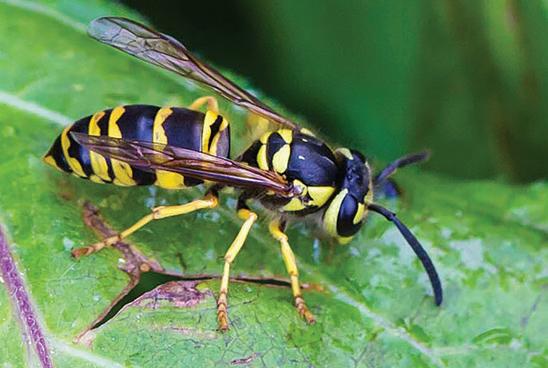
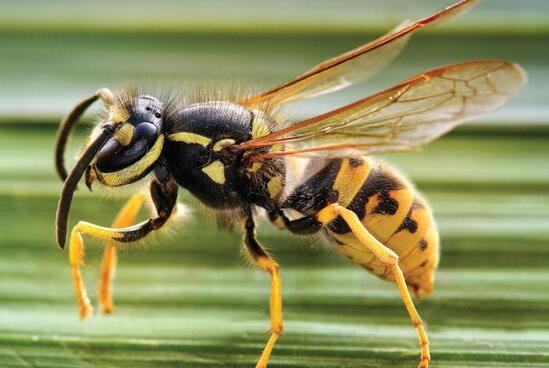
How Eastern Yellow Jackets Help the Ecosystem
These wasps are skilled hunters. They track down caterpillars, grubs, flies, and other soft-bodied insects that would otherwise tear through gardens, crops, and forest undergrowth. They don’t just kill pests, they feed them to their young, which helps control insect populations.
They’re also scavengers, cleaning up decaying meat and dead bugs from the forest floor—stuff that might otherwise rot and spread disease. And while they’re not major pollinators like bees, they do help move a little pollen around while they’re sipping nectar on the side.
Easter yellow jacket.
Photo by Melissa McMasters
German yellow jacket.
Photo by Richard Bartz
The Invasive German Yellow Jacket
German yellow jackets don't just invade structures, they invade ecosystems. They build larger nests, grow colonies quicker, and stay active later into fall. And when food supplies run low, they get mean, aggressively competing for anything sugary, greasy, or meaty.
More than just pests, they've been called “ecological bullies”, pushing aside native yellow jackets, by taking over nesting sites and getting the upper hand on food sources. Over time, native populations can decline, upsetting the delicate natural balance Roan Mountain depends on.
Late Summer Aggression
In spring and early summer, yellow jackets keep busy—raising their young, expanding colonies, and gathering food. By late July, that focus starts to change and Queens stop laying eggs. Workers become restless and aggressive. Food grows scarce.
That’s when your picnic becomes their buffet. Sugary drinks, barbecue, even your garbage become magnets. Yellow jackets swarm, sting repeatedly, and signal for reinforcements. For German yellow jackets especially, this aggression peaks, turning a late-summer afternoon into a hazard.
Why You Should Care
Yellow jacket venom isn’t just painful— it can be life-threatening. Unlike bees, yellow jackets don't lose their stingers. They can hit repeatedly, marking targets and bringing others to attack.
Even if you’ve never had issues before, you can develop an allergy at any point. A
single sting can quickly escalate to a dangerous allergic reaction known as anaphylaxis, requiring immediate medical attention.
When to Coexist and When to Eliminate
If a yellow jacket nest is far off your path—deep in the woods, isolated, and causing no harm—consider leaving it alone. Cold weather naturally takes over. The first hard frost wipes out the colony, and the queen goes underground to ride out the winter alone until it’s time to start fresh in spring.
However, when they set up too close to people, especially the German kind, that’s not something to wait on. Look into your options and figure out the safest way to handle it, before it becomes a bigger problem.
Balancing Act
Roan Mountain has always been about balance— between people, wildlife, pests, and predators. While native yellow jackets are woven naturally into that balance, invasive species disrupt it. When German yellow jackets are set up in your home or near your family, you're not disturbing nature by removing them. You're protecting the very balance Roan Mountain thrives upon.
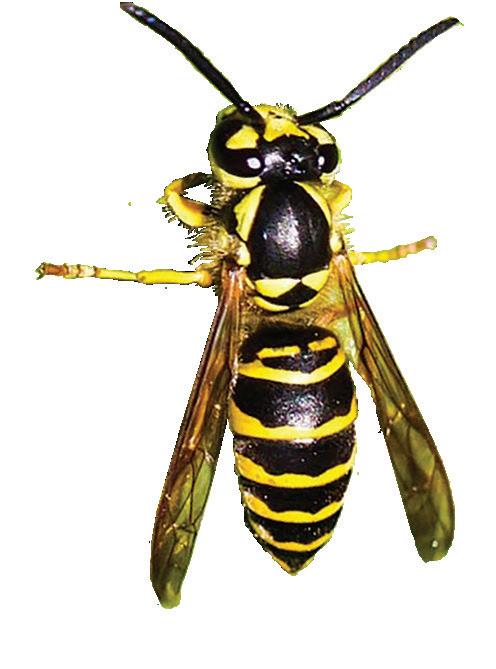
Eastern Yellow Jacket (Native)
At the end of the day, yellow jackets remind us that Roan Mountain isn’t just our home. It’s also the home of creatures doing exactly what they were made to do. Some, like the Eastern yellow jacket, earn their place by keeping the system in check. Others, like the German kind, overstep. The goal isn’t to kill everything that stings. It’s to understand what belongs, and what doesn’t.
How To Tell Them Apart
German Yellow Jacket (Invasive)
• Yellow and black bands, small black dot on face
• Mostly nests underground in quiet places
• Helps control pests and clean up dead insects
• Usually only aggressive near its nest
• Less likely to linger around people
• Bolder body markings, anchor/spear shape on face
• Nests in barns, walls, attics, and other structures
• More aggressive and persistent around food, trash, and humans
• Active deeper into fall
Inset photo by Melissa McMasters
Lightning Safety Lightning Safety

Lightning is one of the most severe weather hazards, yet also the most underestimated. Although annual deaths due to lightning strikes in the U.S. average around 50, hundreds of people are permanently maimed. Given the number of spring and summer storms we experience here, it makes sense to brush up on the facts regarding this natural phenomenon and take life-saving precautions.




STATISTICS STATISTICS
• Summer is the most dangerous season with more lightning fatalities occurring in June, July and August than any other time of year.
• 64% of lightning fatalities result from outdoor recreation and a large portion of those are from water activities.
• Between 2015 and 2019, Tennessee averaged 4,943,089 strikes per year, which translates to 117.7 strikes per square mile, per year. Tennessee ranks 11th in the nation in strikes per square mile.
• Lightning is hotter than the surface of the sun and can reach temperatures around 50,000 degrees.
• Men are four times more likely to be struck by lightning than women.
• About a third of all lightning injuries occur indoors.
• Although the flashes of light we see resulting from a lightning strike travel at the speed of light (670,000,000 mph), the actual lightning strike "only" travels at 270,000 miles per hour.
• Although lightning appears huge in the sky, the average lightning bolt is only two to three centimeters wide. However the average length is two the three miles long.
• Lightning can and does strike the same location more than once. The Empire State Building is struck by lightning an average of 23 times per year.
Facts Facts
Lightning is a rapid discharge of electricity in the atmosphere. Thunder is the result of a shock wave created by rapid heating and cooling of air in the lightning channel. To learn what causes lightning, visit www.weather.gov/safety/lightning-science.
All thunderstorms produce lightning and are dangerous. If you can hear thunder, the storm is close enough for lightning to strike, even if it's sunny where you're standing.
Lightning will strike the same place repeatedly if the object is tall and isolated.
Like water, metal does not attract lightning, but it does conduct it. Removing jewelry and watches during a storm isn't necessary, but staying away from metal (fences, buildings, etc.) that will carry an electric charge to you if it is struck.
Determine the distance of lightning from a location by using the “flash-to-bang rule.” Begin counting at the sight of the lightning flash. Stop counting at the sound of related thunder. Divide the count by five to determine the proximity in miles of the lightning strike (5 seconds = 1 mile; 50 seconds = 10 miles, etc.). Lightning often strikes more than three miles from the center of a thunderstorm, and can strike as far as ten miles away.
• Most cars are safe from lightning, but it is the metal roof and metal sides that protect you, NOT the rubber tires. Remember, convertibles, motorcycles, bicycles, open-shelled vehicles and cars with fiberglass shells offer no protection from lightning. When lightning strikes a vehicle, it goes through the metal frame into the ground. Don't lean on doors during a thunderstorm.
• Laying flat on the ground, hiding under a solitary tree, or seeking shelter in a tent, pavillion, shed or other structure with no plumbing or wiring will not protect you.
Most common “reasons” for being struck by lightning:
• Caught outside and couldn’t get to safety.
• Waited too long to go inside.
• Struck inside while using electrical equipment/devices, corded phones, or plumbing, or touching windows or exterior doors.
• Went back outside too soon.
If you see a person struck by lightning, call 911 immediately. They are no longer dangerous to touch after the strike. Heart attack is the most common result of a strike. Begin CPR if you're trained, and/or use an AED.
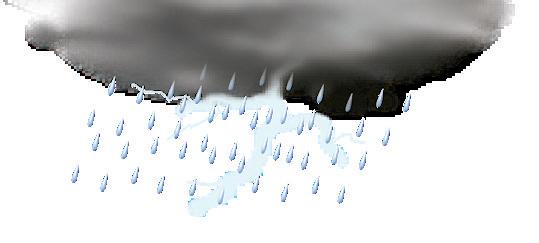
SAFETY Safety
Two factors determine your chances of being struck by lightning: the amount of lightning in the area and your behavior during the storm. You can only control one of those factors.
Prevention
5 Ways you can be struck
5 Ways you can be struck
Direct Strike: A person struck directly by lightning becomes a part of the main lightning discharge channel. Most often, direct strikes occur to victims who are in open areas. Direct strikes are not as common as the other ways people are struck by lightning, but they are potentially the most deadly. The heat produced when lightning moves over the skin can produce burns, but current moving through the body is of greatest concern.
Side Flash or Side Splash: This occurs when lightning strikes a taller object near the victim and a portion of the current jumps from a taller object to the victim. In essence, the person acts as a “short circuit” for some of the energy in the lightning discharge. Side flashes generally occur when the victim is within a foot or two of the object that is struck. Most often, side flash victims have taken shelter under a tree to avoid rain or hail.
Ground Current: When lightning strikes a tree or other tall object, much of the energy travels outward, in or along the ground. This is known as the ground current. Anyone outside near a lightning strike is potentially a victim of ground current. In addition, ground current can travel in garage floors with conductive materials. Because the ground current affects a much larger area than the other causes of lightning casualties, the ground current causes the most lightning deaths and injuries. Typically, the lightning enters the body at the contact point closest to the lightning strike, travels through the cardiovascular and/or nervous systems, and exits the body at the contact point farthest from the lightning. The greater the distance between contact points, the greater the potential for death or serious injury, which is why laying flat on the ground to avoid “being the tallest point” is not safe.
Conduction: Lightning can travel long distances in wires or other metal surfaces. Metal does not attract lightning, but it provides a path for the lightning to follow. Most indoor lightning casualties and some outdoor casualties are due to conduction. Whether inside or outside, anyone in contact with anything connected to metal wires, plumbing, or metal surfaces that extend outside is at risk. This includes anything that plugs into an electrical outlet, water faucets and showers, corded phones, and windows and doors.
Streamers: While not as common as the other types of lightning injuries, people caught in “streamers” are at risk of being killed or injured by lightning. Streamers develop as the downwardmoving leader approaches the ground. Typically, only one of the streamers makes contact with the leader as it approaches the ground and provides the path for the bright return stroke; however, when the main channel discharges, so do all the other streamers in the area. If a person is part of one of these streamers, they could be killed or injured during the streamer discharge even though the lightning channel was not completed between the cloud and the upward streamer.
• Know the area you’re in. Since afternoon thunderstorms are frequent here, plan your outdoor activities for mornings.
• If working or playing outside, determine where you’ll seek shelter if a storm pops up.
• Cancel or postpone outdoor activities if storms are approaching. If you can hear thunder, you are within range of a lightning strike.
• Don’t go outside until 30 minutes after you last hear thunder. Outside
• When you hear thunder, immediately move to safe shelter: a substantial building with electricity or plumbing or an enclosed, metal-topped vehicle with windows up.
• Avoid hills, ridges, and open areas. Do not be the tallest object in the area – but do not lay down, either. Continue moving to search for safety.
• If you are with a group of people, spread out. While this can increase the risk of someone being struck, it reduces the risk of multiple casualties and increases the chances that someone will be able to help or call for assistance.
• If you’re in the woods, stay near a lower stand of trees rather than taller trees.
• Never use a cliff or rocky overhang for shelter.
• Water doesn’t attract electricity but it does conduct it. Immediately get out and away from bodies of water and avoid wet items – even wet ropes can conduct electricity.
• Stay away from objects that conduct electricity (barbed wire/ metal fences, power lines, trees, etc.)
Inside
• Stay off corded phones, computers and other electrical equipment that puts you in direct contact with electricity. (Cordless phones, cell phones and remote controls are safe to use.)
• Avoid plumbing, including sinks, baths and faucets. Don’t wash your hands, take a shower or do dishes.
• Stay away from windows and doors, and stay off porches, stay out of open garages and carports.
• Do not sit or lie on concrete floors, and do not lean against concrete walls.
• Protect your pets. Doghouses are not safe, nor are dogs tied to trees, fences, metal posts or other conductive objects.
• Surge protectors will not protect against lightning strikes. Unplug electronics before the storm, but not during.
• Check to see if your homeowners or renters insurance covers lightning strikes.
• Research ways of protecting your home from lightning strikes. If your house is struck, contact the fire department and ask them to inspect for hot spots and other strike hazards that can lead to fire.
Compiled from information provided by NOAA and the NWS. For more, vist: www.weather.gov/safety/lightning For additional safety information on a variety of topics, visit: www.weather.gov/safety/
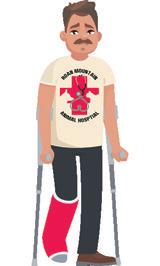
Poor


So
But don’t tease him with humor-ous puns. We all have two legs to stand on, But the doc now only has one.










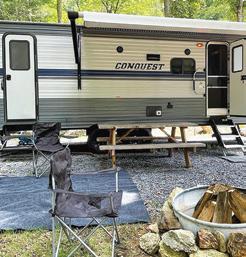


Heat SAFETY Heat safety
Even if you're fit and healthy, heat can be dangerous. Take precautions, know what to look for, and what to do if you or someone near you shows signs of heat-related illness.
Heat-Related Illnesses

SYMPTOMS
WHAT TO DO HEAT STROKE
• High body temperature (103+)
• Hot, red, dry, or damp skin
• Fast, strong pulse
• Headache
• Dizziness
• Nausea
• Confusion
• Fainting/passing out
• Heavy sweating
• Call 911 immediately – heat stroke is a medical emergency
• Move the person to a cooler place
• Remove extra clothing if possible
• Help lower the body temperature with cool cloths or a cool bath
• Do not give the person anything to drink
HEAT EXHAUSTION
• Cold, pale and clammy skin
• Fast, weak pulse
• Nausea or vomiting
• Muscle cramps
• Tiredness or weakness
• Dizziness
• Headache
• Fainting/passing out
• Move to a cool place
• Loosen clothing
• Apply cool wet cloths to body or take a cool bath
• Sip water
• Get medical help immediately if symptoms get worse, include vomiting, or last for longer than one hour
HEAT CRAMPS
• Heavy sweating during exertion
• Muscle pain or spasms
• Painful, red, warm skin
• Blisters
• Stop physical activity, move to a cool place
• Drink water or electrolyte drink
• Wait for cramps to end before resuming activity
• Get medical help immediately if cramps last longer than one hour, you are on a low sodium diet, or if you have heart problems
SUNBURN
• Do not break blisters
• Stay out of sun until sunburn heals
• Apply cool wet cloths to burned area or take a cool bath
• Apply aloe or other burn-soothing ointment or cream
• Get medical attention if blisters cover large portions of the body, or if you experience high fever, nausea, headaches, severe pain, confusion, or chills




















Music Spotlight: A Charlie Daniels Story
By Ericka Hughes
There’s a kind of music that grabs your hand, pulls you through the fire, and leaves you standing with enough strength to try again. Charlie Daniels and his fiddle do that for me. Through storms, losses, and rough days, his music gets me through.
This month’s music spotlight isn’t an interview. It’s a closer look at a man and his music that continues to be respected. Something I felt like sharing, and something I hope you’ll enjoy reading.
There’s no record of Charlie Daniels ever performing here, or walking the grassy balds, but honestly, he didn’t have to. You can hear the mountain in the way he played.
Roots and Early Sparks

Charlie Daniels was born in Wilmington, North Carolina, in 1936. He picked up the guitar first, but by the time he was sixteen, the fiddle had caught his ear. He wasn’t classically trained. He learned by listening close, messing up, and doing it again until it sounded right. And once he found his sound, he never let go of
In his memoir Never Look At The Empty Seats, Charlie wrote about his early fascination with westerns. He was enthralled with the musical scores as much as he was with the plot. It started in his family’s living room, gathered around a Zenith radio. That’s where the cowboy shows and music came through and “rocked his world,” and giving credit as to "where the fantasy of being onstage first started."
His father, though not a musician himself, loved music, and singing at church. Charlie said that love of music passed right down to him. He remembered one Sunday when he was eight, jumping in during a hymn and singing so loud his mother leaned over and said, "Charlie, you’ve got to stop. Everyone's turning around to see who's singing so loud."
Building a Legacy
After years of moving around the Carolinas, playing at small venues and working long days, he relocated to Nashville in 1967. A few years later, he bought land and put down roots in Mt. Juliet, Tennessee, not far from Music City. That place gave him room to breathe and stay grounded, even when the spotlight found him. When most people hear Charlie Daniels’ name, they think of The Devil Went Down to Georgia. Released in
1979, it shot up the charts, earned him a Grammy, and became his signature song. But that one hit doesn’t tell the whole story. Songs like Long Haired Country Boy, Simple Man, and Still in Saigon dug deeper. They showed that he had working-class roots, principles, and no fear of saying what he thought.
He wasn’t just a performer; he was a gatherer. In 1974, Charlie launched the Volunteer Jam in Nashville. It wasn’t your typical concert, and had no setlists, with many musicians showing up to play. Legends like The Marshall Tucker Band, Willie Nelson, and Lynyrd Skynyrd, were some to join in.
Charlie also worked as a session player before his solo career took off. In the 1960s, he played on Bob Dylan’s Nashville Skyline and on records for Leonard Cohen and Ringo Starr.
Earned From Hard Work
Charlie Daniels was no stranger to labor. Long before he ever saw his name in lights, he worked in lumber yards, hauled tobacco, and laid bricks to help pay the bills. He credited those jobs for shaping his character, and said the discipline they taught stuck with him longer than any record deal. In his memoir, he wrote about rising early and finishing the day covered in sweat, knowing that “music would still be waiting on the other side. That’s what made it matter more.”
One of his early bands had to travel in beat-up vehicles, playing anywhere they could find a crowd. There were times they didn’t have the money for hotel rooms, so they slept in the car. Charlie saw those moments not as setbacks, but as stepping stones. He called it “paying dues.”
What Didn’t Stop Him
As a young man, Charlie lost part of his left ring finger in shop class. That finger plays a big role in grip, reach, and timing. But Charlie adjusted. He found a new way to hold the neck, kept playing, and never let it slow him down.
Then years later, out on his ranch in Mount Juliet, he broke his arm in a post-hole digger accident. Another hit that could’ve ended things. But Charlie didn’t hang it up. He healed, kept working, and kept playing. That kind of hard edge doesn’t show up in every person. It’s not something you practice. It’s just who you are.
A Legacy You Can Still Hear
Charlie Daniels passed away in 2020, but his music didn’t. It’s still shaking barn walls and pouring out of radios up and down these back roads. It’s the kind of sound that shows up when you need it most.
Next time life gets heavy, turn Charlie up. Let that fiddle remind you—you’ve been through worse. And you’re still standing.






Resilient Roan: Stories of Recovery
A "Flood" of Blessings
By Renee Russell
Nathan and Emily Purcell moved to Roan Mountain ten years ago. After moving twice during their first eight years here, they finally nestled into a two-story farm house they purchased two years ago. The house was spacious enough for this growing family that consisted of five children, two of whom were foster children.
Everything was moving along smoothly for the Purcells in their new home until September 27th, 2024, when Hurricane Helene caused serious damage to the house, both inside and outside.
Inside, mud and water rose to almost four feet in every room on the main level, destroying their furniture, appliances and personal belongings. The basement crawl space (where the family’s jarred food was housed), was also affected with most of the contents washed away or destroyed.
The day following the flood, Nathan and Emily noticed that several roads in their neighborhood were ravaged with deep sink holes. There was also a downed power line lying across the road which Nathan bravely moved to a safer location. During this time a serious car accident occurred on Highway 19E close to the Purcell’s. As traffic was redirected to their road, Nathan realized the danger this could create for cars traveling on this street, so he and Emily went out and directed the traffic to keep people safe.
In spite of the devastation, this determined couple began immediately taking steps to ensure the safety of their family. After the flood they remained in their house, staying on the undamaged second floor for two weeks. Nathan and Emily somehow ensured that the family would have access to food, thanks to a propane tank and packaged food items. Immediately, people from different churches started showing up to the family’s house with food and other necessities, including Nathan’s 72-year-old church pastor, who also assisted with shoveling mud.
In the days following the flood, some of Nathan’s neighbors, including his friend, Caleb Denton, came by to help with restoration. Cars were still trying to muddle through the dire road conditions; some stopped to help, while others literally threw money out of their car windows for the family. Emily added, “We could not believe it when, the next day, some of those drivers, people we did not know, came back to help us.” Neighbors and strangers also dropped off supplies, helped with pressure washing the inside of the house,
and assisted with the subfloor. Others from outside the area were also showing up to lend their hands.
One of the greatest blessings was when the owner of a nearby Airbnb offered the Purcell family a place to stay for two months free of charge.
When Christmas rolled around, the family was in awe of all of the gifts that were delivered to them from churches, neighbors, friends, and even a mule team group from Maryland. The entire living room was filled with treasures for the children and helpful items for Emily and Nathan. They were so grateful for the kindness and generosity from all who contributed.
However, a greater gift arrived in January. Their sixth child, a foster baby, joined the family. Even though the Purcells had very little at that time, that did not stop Emily from going to the hospital to bring the baby home. A band of churches gathered and dropped off many supplies for their new addition.
The eldest child, eight-year-old Jesse, also participated in this interview. When asked what he did to help, he responded, “I got to help. I helped with the plumbing, and I took care of my sister and brothers. I even changed the baby’s diapers. I also crawled down the basement crawl space to help with fixing it up.” His younger brother, Eli, said he, too, assisted with the subfloor damage.
Jesse also shared his love for God and demonstrated this by reading his favorite Scripture from his Bible. Nathan and Emily attested to the greatest blessing from this disastrous event, which included all that God had provided to and for them which, of course, included all of those generous and helpful friends, neighbors, and those whom they had never met before. This has all led to their home being almost back to normal. Emily said, “There are just small fix-up projects to do now. We are so thankful for that as well as everyone who helped throughout the disaster.”
When asked what stood out to him regarding this disaster, Jesse responded with, “I love that the people here are so close.” Out of the mouth of babes, indeed!
Beneath the Fireworks
Keeping Our Pets Safe
By Ericka Hughes
July might be best known for fireworks on the fourth—and let’s be honest, those loud pops and booms aren't limited to one night. All month long, neighborhoods come alive with the sound of celebration. And while the skies light up for us, that same joy can turn into a nightmare for our animals.
This article isn’t about spoiling the fun. It’s about awareness. Because even if you don’t have pets, chances are you live near someone who does. And the truth is, fireworks aren’t just noisy. For animals, they can be dangerous in more ways than one.
Why It's Not a Holiday to Them
To a dog, a firework isn’t just sound, it’s a threat. There’s no warning, no rhythm to anticipate, and no way for them to make sense of it. Their hearing is far sharper than ours. What’s loud to us can rattle them straight to the bone.
Some dogs tremble. Others hide. Some panic so hard they’ll crash through screen doors or scale fences to escape. A few may even growl or snap if cornered. That’s not misbehavior. It’s survival mode.
And it’s not just dogs. Cats might not wear their panic the same way, but they can feel it too. Sudden blasts can send them diving for cover. So don’t overlook your feline friends during firework season either.
Fireworks are beautiful, sure. But they can also be terrifying. We’ve learned to expect them—our animals haven’t. Their fear isn’t weakness, it’s biology. And through all of it, they’re looking to us to keep them safe. As you light up the sky this July, take a moment to remember what’s happening at ground level.
Happy Independence Day! Let's all celebrate it safely, together.
Keep them inside
How to Help
Even if your dog usually stays outdoors, firework season is different. If possible, bring them in before dusk. July 4th is the number one day for lost pets.
Create a safe space
A quiet room away from windows can help. A crate, bed, or corner with a blanket and familiar smells gives them somewhere to settle.
Don’t punish fear
If they’re drooling, pacing, or trying to crawl into your lap, let them. Stay calm. Talk low and slow. Just be near.
Walk early
Exercise helps burn off anxious energy. Get that walk in before the fireworks start.
Drive carefully
Panicked dogs might bolt into the road. Be alert, especially at night, and even after the fireworks have ended.
Be neighborly
If you’re lighting fireworks, give nearby folks a headsup—especially those with pets or livestock. A quick heads-up goes further than you think.

Terrified, Remington spends half the time on his mama's lap and the other half cowering in the bathroom.
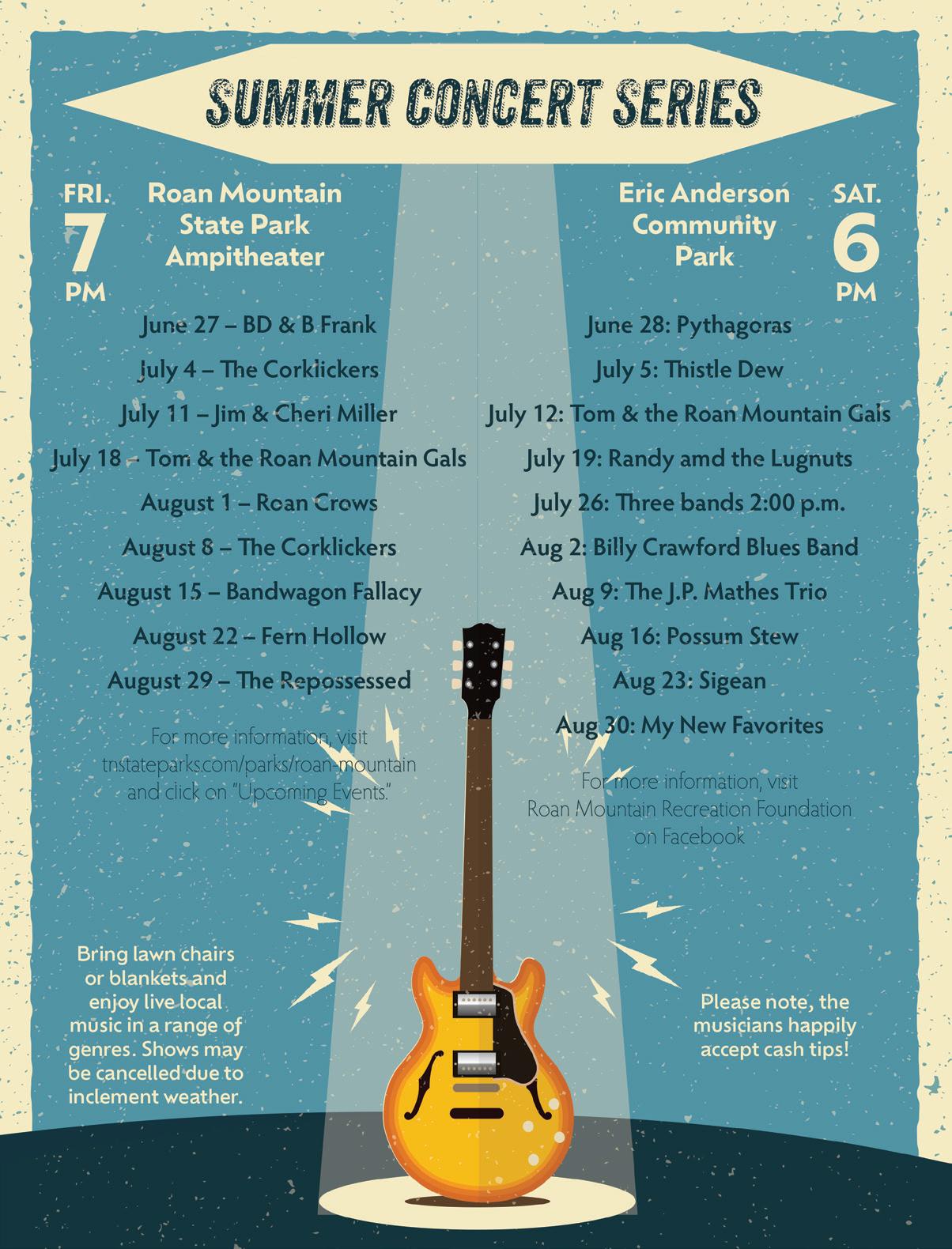
The Price of Freedom
A Short Story by Diana Tolley
Sweat dripped into Grady O’Conner’s eyes, but he didn’t bother to wipe it with the back of his hand. Instead, he blinked it away, the slight stinging of the briny fluid causing him to squint. Flashes of light overhead lit up the night sky a few seconds before the sound of canons and gunfire reached his ears. Who would have ever thought a young farm boy from the Cherokee mountains would have ever found himself hunkered down in a copse of Loblolly Pines, waitin’ for the Red Coats to march past? The rhythmic thump of their fine, leather boots sounded awfully familiar. Kind of like Paw’s old mule team back home. Grady felt his eyes mist up as thoughts of his family crossed his mind. As far as he could figure the date, it was that time of year for the first cuttin’ of hay. Sure that his younger brothers were pitchin’ in to help, he only felt just a little guilty about not being there. This war seemed to be lasting forever, and everybody that Grady had run across in the colonial troops was plenty homesick; that included him.
When he’d first gotten the notion to join up, his ma had pitched a fit. Men from the Watauga settlement had come around talking about General Washington and how patriots were standing for what was right. They talked about how the English aimed to lay claim to all the new land and wanted all the settlers to be loyal to a king that nobody even knew. Nobody in the mountain area where Grady lived, anyway. Just wasn’t right in his book. From all accounts that he and his family had heard, General George Washington had the right of it: fight for the freedom to live as a man chose, to be independent and govern his people as the good Lord seen fit. Most agreed with those very sentiments,

but what sealed the deal for Grady, was when news came to light that his cousins from Yorktown had already signed up and were fighting for the Continental Army. A body couldn’t let family fight alone. His pa was too old and his brothers, too young. At 16 years of age, it was left to him to go fight the good fight. When he’d left, his ma was crying in her apron while his pa had nodded with understanding.
It’d been hard and the memory of that day would stay with him forever.
Silence brought Grady back to the present. The English troops had finally moved on down the road and the area had settled into a tenuous calm. Quietly easing out of his hidey-hole, the young soldier slowly straightened, keeping his eyes on the dirt road and his ears open for the rest of his militia. He was part of what they called Irregular fighters. They were small groups of militiamen that used tactics like ambushes and hide-n-seek attacks that left British forces scratching their heads while watching their troops slowly diminish. The groups had, so far, been successful in disrupting the Brits orderly war against the Colonial Army. They’d picked mountain men for those special kind of fighters, because they were smart and knew tricks from fighting for survival that many did not. Grady was proud that they’d recruited him. He liked out-smartin’ the Redcoats.
Turning, the young soldier was about to give a low whistle to signal the all-clear, when something whizzed by his left ear. The sound hadn’t even registered before a soft ‘kahTHUNK’ hit him in the chest. By the time the third shot hit the left side of his neck, Grady knew he was in trouble. He turned and dove down in the laurel
thicket that he’d just come out of. His shoulder stung like a thousand hornets but, interestingly enough, his neck just felt wet. He rolled down the embankment then crawled up underneath an uprooted sycamore. He tried to slow his breathing but for the life of him, he couldn’t seem to make his lungs cooperate. His heart was beating pretty fast but sped up more as shouts of men fighting sounded up on the road above him. What seemed like an eternity before all was quiet again was actually less than 10 minutes. Grady knew he needed to find his men and regroup so he rolled out from underneath his cover and tried to stand up. Apparently his legs weren’t cooperating either. Weariness and fatigue washed over him like the time he’d had the ague. That was the weakest feeling he’d ever had in his life and now it was back. Grady tried to take a big deep breath but the wound in his neck spasmed and he felt warm rivulets trail down his chest. He managed to pull himself up holding onto his rifle and the bare roots of the sycamore, but it made his head spin and his knees buckled. The next thing the young soldier knew, he was lying flat on his back, looking up at stars shining in a clear night sky. Flashes of light lit up much of the canopy above, like an impending thunderstorm headed his way. However, the distant lights and sounds were not thunder; it was cannon fire. Grady couldn’t help thinking how pretty the lights played against the dark, twinkling background of the heavens. Mama had read to them from the Bible since her children had been born, teaching them verses so they could call upon them during times of trouble. In that particular moment though, the only scripture that he could recall was, “When I consider your heavens, the work of your fingers, the moon and the stars, which you have set in place, what is mankind that you are mindful of them, human beings that you care for them?" It was from the book of Psalms, if he wasn’t mistaken; Psalm 8:3-4. Grady chuckled, which, then in turn, made him cough. “I sure don’t think gunpowder adds much to the beauty, Lord.” He whispered.
Suddenly, a gentle arm slid underneath his shoulders causing his neck to sting pretty bad. Coughing again, Grady tried to turn his head to see who it was but for some reason, he couldn’t seem to manage it. A cool, peaceful stillness swept over him. “Is that you, Ma?” He asked in a strangled whisper.
right, so that the brothers and their families don’t have to bow to nobody but God; just like you and Ma taught us.”
He coughed a tiny bit making his voice sound a little strained. “I reckon that’s what a man does for the ones he loves. Ain’t that right, Pa?” Grady watched as what must’ve been clouds gathered and made the sky appear more dim. The flashes of light no longer were visible either. All was quiet. The sounds of war were gone.

“No. But you’re right, son. Nothing could ever add to the beauty of God’s firmament.” The voice wasn’t that of his mother. It was deeper and more masculine, but just as gentle. “Pa? How’d you find me, Pa?” Grady asked with a small smile.
“I’ve known where you were your entire life,” the voice replied. “Because I’ve been right beside you every step of the way. I’ve never left you.”
A cold numbness now filled his chest, taking the awful pain away but weighing it down and making it harder to breathe.
“I’ve fought a good fight, Pa. I’ve stood for what’s
“Yes indeed,” the voice said softly. “That’s what a son does for his father and the people he loves, Grady. The fight is almost over now. You’ve done your duty and it’s time to go home. Well done, soldier. Well done.”
Grady smiled. He wasn’t feeling any pain at all and now that he was goin’ home, all would be well. Maybe he’d be strong enough to help get the second cuttin’ of hay in with Pa and the brothers come fall. Funny how a body could miss something so simple.
He felt himself being lifted, light as a feather, by warm, gentle arms. The sky somehow appeared closer to him, and he yawned, more tired than he could ever remember.
Being carried wasn’t so bad, he reckoned, seeing as how his father was headed in the right direction. “I’m probably gonna sleep now, Pa.” He whispered.
“Yes. Rest now, son. You’ll be home when you wake.“ The deep timber of the voice soothed him so much.
As Grady O’Conner closed his eyes and took his last deep breath, he thought of freedom … and the price that was being paid for it. Soldiers from every walk of life, giving life and limb, with one goal in mind: to be a new nation, and protect its people. One Nation Under God. That sure had a nice ring to it …
As we celebrate this Independence Day, let’s not forget all who fought in the Revolutionary War to bring about a country we love dearly. And those who are fighting now, continuously, every day, to preserve our freedom and protect the rights we often take for granted in the here and now. The Revolutionary War was just the beginning, significantly influencing the Bill of Rights, the first ten amendments to the U.S. Constitution. These amendments, ratified in 1791, address the fundamental rights and liberties, directly stemming from hardships and grievances under British rule.
Remember that Independence Day isn’t just a holiday; it is a day to remember the sacrifices of many brave warriors and their families down thru the years and into our present.
God bless America. Let Freedom Ring!
Meet Colleen - Social Media Guru
If you follow Roan Mountain Magazine on Facebook (and we hope you are!), you might have noticed an uptick in activity recently. That’s down to Colleen Gainey, who’s joined our team as our social media manager.
Activity on our Facebook page (and eventually an Instagram page) has multiple benefits:
• It helps promote our advertisers, providing extra value for their support
• It helps promote our writers and photographers who work so hard to provide us with interesting content
• It helps the magazine engage more with you, our readers who are online
• It’s just plain fun – such as Colleen’s post “Show us your chickens!” Who doesn’t love to see chicken pictures?
In addition to sharing articles from the print issue or news tidbits that come in after the issue has gone to print, she’ll welcome new advertisers and spotlight existing advertisers, update you with magazine news, post fun and interesting topics, and more. Also, on “Sunday Fun Day” she’ll post a list of activities coming up that week. If you have events happening and want to let the community know, please send them to Colleen through the magazine’s messenger or you can call or text her: (321) 446-8628
Colleen is new to the area, originally from South Carolina. Ironically, she and Susie Phillips, who handles advertising for the magazine, lived just miles from each other near Columbia for many years, but just met here, while working with the magazine!
Colleen is also a Tupperware distributor so get in touch for all your Tupperware needs, or to share ideas for social media. She's eager to become part of our amazing community!





Tupper Tip:
Never store bowls and containers with the seals on. It will trap odor in the containers.
Colleen Gainey - Owner 321-446-8628
Find me on Facebook at Tupper-holics Anonymous for all the latest products, sales and specials! bit.ly/tupper-holics-anonymous




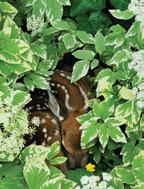
It was late July. The kind of day when the air is humid, the ground’s soft, and the brush is thick. I was weedeating down by a muddy creek. Sun was out, the machine was humming, nothing seemed out of place. Then came the sting—sharp and familiar. It turns out I'd been weedeating over an underground yellow jacket nest. I didn’t stay to see what else was coming. I let the weedeater hit the ground and didn’t look back— just left it rattling on the ground while I cleared out. I’ve learned that when you stir up a nest, your best move is to drop the equipment and back away. Yellow jackets are drawn to heat and vibration, so the running machine can buy you a few seconds—just enough to get clear.
A few yards away, I yanked up my pant leg. The sting site was already red and swelling. I’d had my share of wasp and bee stings over the years and never thought twice about it. But this time, something was different. Welts began to spread across my arms and up my chest. My head went light and my throat was tight and scratchy.
I told the foreman and he took me to the ER. There, the doctor diagnosed me with a severe allergy to yellow jackets—also called adult-onset venom allergy, something that can develop suddenly, even after a lifetime of stings, even if you’ve never had an allergic reaction before. He explained how serious the situation was. If I’d ignored the signs or stayed out there too long, it would have turned into fullblown anaphylaxis—a severe, life-threatening allergic reaction that can close your airway within minutes.
The sting didn’t just leave a mark on my skin, it left a mark on my mind. For weeks after, I wasn’t the same. My work performance slipped. I wasn’t efficient. I was scared. I dreaded going to work each morning. The sound of a fly buzzing by my ear would stop me cold. I’d flinch, panic, walk away from jobs half-finished. I was psyching myself out, and it got worse every day. I started to think maybe I wanted to quit. I felt useless, like I’d lost the edge that kept me going all these years.
But the more I thought about it, something in me shifted. I turned that fear into anger—then into willpower. I thought about the years I’d spent working, the pride I felt when I did a job right, the people who counted on me to show up and do my part. Was I really going to let one sting stop me? I came to my senses—in more ways than one.
I went back to work, and I was lucky to keep my job through all of it—through the hesitation, the fear, and the days I wasn’t myself. I was fortunate to have a foreman who understood what I’d been through. When I came back, he gave me some good advice, “Take your time. Two minutes. Look around. Bang on things. Do a quick walkabout. It makes a difference".
And it does. Now, I make a point of slowing down. Before I even pull the cord on a machine, I walk the

LESSONS IN LIFE & LANDSCAPING One
Sting Changed Everything
By Ericka Hughes
ground and look around. I know that what you can’t see is often what can knock you off your feet the hardest. So I pay closer attention to the places that don’t draw your eye, especially on new jobs. Because in this work, it’s not always the noise or the obvious threat that’ll get you—it’s what’s been waiting quietly all along. And the only way to see it is to give yourself the time and space to look.
Life's Lesson:
That fear didn’t make me weaker—it made me sharper. Because out here, the smallest thing can upend your whole day in a blink.
Yellow jackets have their place in nature, but they’re no joke when it comes to safety. Respect their role, and the ground you walk on. And always watch where you’re stepping.
Tips from the Lawn:
• Awareness of a nest is the best way to avoid bees. Keep your eyes open.
• Look for bee traffic—one bee going in and out of the same spot is sometimes the only warning you might get.
• Not all bees act the same. Honey bees and bumble bees won’t chase machinery the way yellow jackets will.
• Late summer to fall, they’re most aggressive. Colonies are full, food is short, and defenses are up.
• Keep your mouth closed. A sting in the throat can close your airway in seconds.
• Anaphylaxis can happen to anyone. Even if you’ve never reacted before.
Key signs to watch for:
• Swelling, rash, or welts that show up beyond the sting site.
• Tightness in your throat, dizziness, nausea, confusion Benadryl or an EpiPen buys you time, but only time. Get medical help immediately.
Fun & Games
(For kids of ALL ages!)


Can you get to the flag?
July Word Search
Amelia Earhart
America
American
Apple
Barbecue
Baseball
Buck
Fireworks
Freedom
George
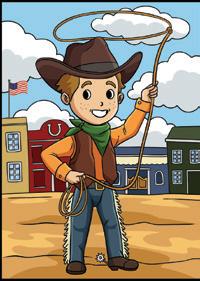
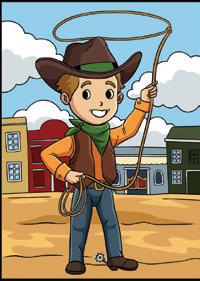



We Look to the Sky
A Poem by Ericka Huges

By the time dusk folds over the ridgeline, you can feel it, that electric hush rolling in with the smoke of firecrackers and grills burning down to coals.
The whistles and crackling, split the sky, then drift down to voices in the grass, where folding chairs outnumber stars.
It’s not about the noise. It’s about the weight beneath it, what it cost to live this loud, this proud, this free.
And when each rocket rips the night like a shout into the universe, you can almost hear
every name ever whispered in war, every flag folded, every dream hauled uphill just to see it wave.
Roan Mountain doesn’t just watch fireworks. It holds them. It honors them. And it reminds us freedom isn’t just a word, it’s work. Ongoing. Uneven. Worth it.
So let the sky blaze. Let the drums of July shake these mountains. We are still here. And we are the kind of people who look up, hold still, and remember.
THE LAST WORD
Ditch the Stink
By Noah Blair
We are well into that time of year where the temperature outside is easily measured by the number of fashionable Crocs on people’s feet and the allfamiliar smell of body odor, or B.O. as the kids call it. This, in early human history, was just part of life (the B.O., not the Crocs). The good news is that thanks to the folks at Old Spice, Degree, Dove, and the like, we have deodorants, perfumes and soaps to cover up and clean the unpleasant odors before they’re introduced to our co-workers, family or fellow airline passengers (you know who you are).
Unfortunately, the quest to conquer the “human stink” epidemic (big fragrance, as I call it) has settled for cheap and potentially harmful ingredients that can cause irritation, dryness and skin conditions. As someone who has sensitive skin but is not immune to sweat and stink, I just dealt with the dry itchy skin that these products cause, until my wife brought some soap home from a friend at work and was hooked instantly.
The soap is handmade in Elizabethton by a lady named Madison. She first got into soap making during the Covid-19 pandemic as a way to spend that extra free time the pandemic provided. This grew into a hobby that Madison told me became therapeutic and was the first time she felt like she had something she that was hers. The first batch was all it took for her to become convinced that this was what she wanted to do.
Soap making has a very specific science behind it and while I won't go into too much detail, I can confidently say it takes a skilled individual and Madison knows her stuff! Her favorite part of the process is the creative portion of deciding colors and fragrance to make the soap unique. Madison is proud to say she uses products that are safe for our skin and environmentally sound while also being humane and responsibly tested.
She has plans to one day offer a full line of allnatural and skin-safe body care products while also

offering a line of body care for your pets as well. The goal is to provide every home with safe and clean body care products for everyone in the home. Whether they have tails or not.
When asked what her advice would be for anyone thinking about opening their own small business or starting a new hobby she gave me some of the best advice I’ve heard recently. She said, “Pick something you enjoy doing, and that you could benefit from, so there isn’t so much pressure to be profitable at first. If you do something you enjoy and can use, nothing is wasted.”
I can personally attest that Madison’s soaps have helped my skin, get me clean, and smell amazing. Madison has multiple ways to get in touch and to order her soap. She would greatly appreciate the support in building her business. Her Facebook is Madz Sudz, Instagram name is @madz.sudz and email is shopmadzsudz@gmail.com. Tell her Noah sent you!
See you out there, and remember God Loves you!

Photos provided by Madz Sudz


